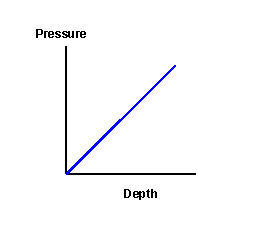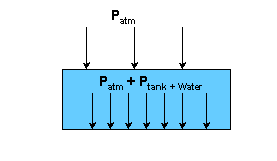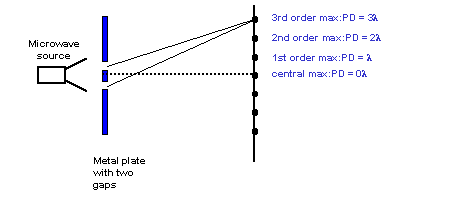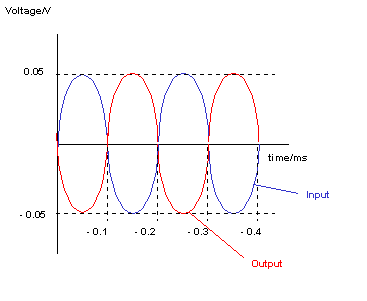
Solutions to SQA examination
Higher Grade Physics
2003
Return to past paper index page.
Section A
1. D 11. D
2. E 12. E
3. A 13. C
4. D 14. B
5. A 15. B
6. C 16. B
7. E 17. D
8. C 18. A
9. B 19. E
10.E 20. A
Section B
21.a.i. Vhorizontal=Vresultant x cosq
V=35xcos40o
Vhor = 26.81(m/s)
a.ii. Vvertical=Vresultant x sinq
Vver=35xsin40o
Vver = 22.5(m/s)
a.iii.Maximum height reached when the vertical component
of velocity (Vver) is 0m/s.
The vertical component of velocity calculated in part a.ii.
is the initial velocity (u) for the purpose of this calculation.
vver = 0(m/s)
uver = 22.5(m/s)
a = -9.8(m/s/s)
t = ?
v = u + at
t = (v-u)/a
t = (0-22.5)/-9.8
t = 2.29(s)
b. Horizontal distance is calculated by multiplying the
total time of flight by the horizontal velocity, which
is constant throughout the flight.
Total time = [(2x2.29) + 0.48]s
ttotal = 5.06(s)
Vhor=26.81(m/s)
d = Vhor x ttotal
d = 26.81(m/s)x5.06(s)
d = 135.66(m)
22.a. DPs = ms(vs-us)
DPs = 38(4.6-2.2)
DPs = 91.2(kgm/s)
b. Favgtc = DP
tc = DP/Favg
tc = 91.2/130
tc = 0.7(s)
c. DPR = -DPS
DPR = -91.2(kgm/s)
DPR = mR(vR-uR)
-91.2 = 54(vR-2.2)
vR = 0.51(m/s)
d. If kinetic energy is conserved the interaction is elastic.
Ekbefore = 1/2MRUR2 + 1/2MSUS2
Ekbefore = 0.5x54x2.22 + 0.5x38X2.22
Ekbefore = 222.64(J)
Ekafter = 1/2MRVR2 + 1/2MSVS2
Ekafter = 0.5x54x0.512 + 0.5x38x4.62
Ekafter = 409(J)
The gain in kinetic energy indicates that the collision is NOT ELASTIC.
The interaction is more like an explosion.
23.a.i.
 a.ii. Pliquid = rgh
Pliquid = 1000x9.8x0.25
Pliquid = 2450(Pa)
a.iii.As the depth increases the total pressure acting on the air inside
the tubing increases. Liquid enters the tube,compressing the air, until
the total pressure acting on the air inside the tube is equal to the
pressure of the air inside the tube.
b. The pressure resulting from tank and water can
be calculated using:
P = F/A where F is the weight of the tank and water.
F = wtotal = mtotalg
wtotal = (2.7x103+300)9.8
wtotal = 3000x9.8
wtotal = 29400(N)
A = 2.0x1.5 = 3.0m2
P = 29400/3
P = 9800(Pa)
Atmospheric pressure is pushing down on the tank. This means that
the total pressure acting on the surface that the tank is resting
on is the sum of the atmospheric pressure and the pressure resulting
from the weight of the tank.
a.ii. Pliquid = rgh
Pliquid = 1000x9.8x0.25
Pliquid = 2450(Pa)
a.iii.As the depth increases the total pressure acting on the air inside
the tubing increases. Liquid enters the tube,compressing the air, until
the total pressure acting on the air inside the tube is equal to the
pressure of the air inside the tube.
b. The pressure resulting from tank and water can
be calculated using:
P = F/A where F is the weight of the tank and water.
F = wtotal = mtotalg
wtotal = (2.7x103+300)9.8
wtotal = 3000x9.8
wtotal = 29400(N)
A = 2.0x1.5 = 3.0m2
P = 29400/3
P = 9800(Pa)
Atmospheric pressure is pushing down on the tank. This means that
the total pressure acting on the surface that the tank is resting
on is the sum of the atmospheric pressure and the pressure resulting
from the weight of the tank.
 Ptotal = Ptank+water + Patmospheric
Ptotal = 9800 + 1.01x105
Ptotal = 1.108x105(Pa)
24.a. P1 = 1.56x105Pa
T1 = (27+273)K = 300k
P2 = ?
T2 = (77+273)K = 350k
P1/T1 = P2/T2
P2 = P1T2/T1
P2 = 1.56x105x350/300
P2 = 1.82x105Pa
b.i. P = I2Relement
I = V/Rtotal
I = 30/(0.5+1.5) = 30/2
I = 15A
P = 152x0.5
P = 112.5W
b.ii. The output power of the element would be less.
This is because the current in the circuit would be
less because of the increase of the total series
resistance of the circuit.
Other explanations involving Vtpd are also valid.
25.a.i. Y-gain = 5volts/div
a.ii.f = 1/T
T = 2.5ms = 2.5x10-3
f = 1/2.5x10-3
f = 400Hz
b.i. VRMS = VPeak/SQRT2
VRMS = 12/1.414
VRMS = 8.49V
b.ii. E = 1/2(CVpk2)
E = 1/2(220x10-6x122)
E = 0.016J
b.iii. The reading on the ammeter increases because the
current is directly proportional to the frequency.
b.iv. The capacitor is constantly charging and discharging,
as the polarity of the supply voltage changes in this
ac circuit. The flow of charge during this process means
that the current in the circuit does not fall to zero.
In a dc circuit the capacitor charges and opposes the
flow of charge from the supply. When fully charged no
current flows in the circuit.
26.a. When the bridge is balanced:
R1/R2 = R3/R4
Where R1 = 5500W
R2 = RLDR
R3 = 330000W
R4 = 150000W
RLDR = (R1xR4)/R3
RLDR = (5500x150000)/330000)
RLDR = 2500W
b.i. MOSFET (n-channel)
b.ii.V1 = VX = 1.28V
V2 = VY = 1.50V
Vouput = (Rfeedback/R1)x(V2-V1)
Vouput = (22.5/1.5)x(1.5-1.28)
Vouput = 15x0.22
Vouput = 3.3V
b.iii.When water reaches the maximum level the beam of
light is not totally internally reflected. This means
that the light intensity incident on the LDR decreases,
increasing its resistance and increasing VX.
This decreases the output voltage from the differential
amplifier. When the output voltage falls below 2.0V
the MOSFET does not conduct and the current in the
solenoid falls to zero, closing the valve.
26.c. The incident angle at the glass water boundary is less
than the critical angle so there is no total internal
reflection.
27.a.i. The energy of the emitted photon is equal to the
energy difference between levels.The longest wavelength
radiation will have the lowest frequency and energy.
The smallest energy gap is beween E4 and E3
a.ii. Ephoton = E3-E2
Ephoton = (-2.4x10-19)-(-5.6x10-19)
Ephoton = 3.2x10-19J
Ephoton = hf
f = Ephoton/h
f = 3.2x10-19/6.63x10-34
f = 4.83x1014Hz
b.i. fair = fglass
fglass = 4.74x1014Hz
b.ii. vair = fairlair
lair = vair/fair
lair = 3x108/4.74x1014
lair = 632.9nm
lglass = lair/n
lglass = 632.9/1.6
lglass = 395.6nm
28.a.i. Maxima are produced when the path difference of the microwaves,
from each gap, to a point along AB is zero or a whole number of
wavelengths. This is because constructive interference occurs
at these points as the waves are in phase.
Minima are produced when the path difference of the microwaves,
from each gap, to a point along AB is l/2, 3l/2, 5l/2, 7l/2 etc.
This is because destructive interference occurs at these points
as the waves are P out of phase.
a.ii.
Ptotal = Ptank+water + Patmospheric
Ptotal = 9800 + 1.01x105
Ptotal = 1.108x105(Pa)
24.a. P1 = 1.56x105Pa
T1 = (27+273)K = 300k
P2 = ?
T2 = (77+273)K = 350k
P1/T1 = P2/T2
P2 = P1T2/T1
P2 = 1.56x105x350/300
P2 = 1.82x105Pa
b.i. P = I2Relement
I = V/Rtotal
I = 30/(0.5+1.5) = 30/2
I = 15A
P = 152x0.5
P = 112.5W
b.ii. The output power of the element would be less.
This is because the current in the circuit would be
less because of the increase of the total series
resistance of the circuit.
Other explanations involving Vtpd are also valid.
25.a.i. Y-gain = 5volts/div
a.ii.f = 1/T
T = 2.5ms = 2.5x10-3
f = 1/2.5x10-3
f = 400Hz
b.i. VRMS = VPeak/SQRT2
VRMS = 12/1.414
VRMS = 8.49V
b.ii. E = 1/2(CVpk2)
E = 1/2(220x10-6x122)
E = 0.016J
b.iii. The reading on the ammeter increases because the
current is directly proportional to the frequency.
b.iv. The capacitor is constantly charging and discharging,
as the polarity of the supply voltage changes in this
ac circuit. The flow of charge during this process means
that the current in the circuit does not fall to zero.
In a dc circuit the capacitor charges and opposes the
flow of charge from the supply. When fully charged no
current flows in the circuit.
26.a. When the bridge is balanced:
R1/R2 = R3/R4
Where R1 = 5500W
R2 = RLDR
R3 = 330000W
R4 = 150000W
RLDR = (R1xR4)/R3
RLDR = (5500x150000)/330000)
RLDR = 2500W
b.i. MOSFET (n-channel)
b.ii.V1 = VX = 1.28V
V2 = VY = 1.50V
Vouput = (Rfeedback/R1)x(V2-V1)
Vouput = (22.5/1.5)x(1.5-1.28)
Vouput = 15x0.22
Vouput = 3.3V
b.iii.When water reaches the maximum level the beam of
light is not totally internally reflected. This means
that the light intensity incident on the LDR decreases,
increasing its resistance and increasing VX.
This decreases the output voltage from the differential
amplifier. When the output voltage falls below 2.0V
the MOSFET does not conduct and the current in the
solenoid falls to zero, closing the valve.
26.c. The incident angle at the glass water boundary is less
than the critical angle so there is no total internal
reflection.
27.a.i. The energy of the emitted photon is equal to the
energy difference between levels.The longest wavelength
radiation will have the lowest frequency and energy.
The smallest energy gap is beween E4 and E3
a.ii. Ephoton = E3-E2
Ephoton = (-2.4x10-19)-(-5.6x10-19)
Ephoton = 3.2x10-19J
Ephoton = hf
f = Ephoton/h
f = 3.2x10-19/6.63x10-34
f = 4.83x1014Hz
b.i. fair = fglass
fglass = 4.74x1014Hz
b.ii. vair = fairlair
lair = vair/fair
lair = 3x108/4.74x1014
lair = 632.9nm
lglass = lair/n
lglass = 632.9/1.6
lglass = 395.6nm
28.a.i. Maxima are produced when the path difference of the microwaves,
from each gap, to a point along AB is zero or a whole number of
wavelengths. This is because constructive interference occurs
at these points as the waves are in phase.
Minima are produced when the path difference of the microwaves,
from each gap, to a point along AB is l/2, 3l/2, 5l/2, 7l/2 etc.
This is because destructive interference occurs at these points
as the waves are P out of phase.
a.ii.
 PD = (766 - 682)mm
PD = 84mm
Third Max PD = 3l
3l = 84mm
l = 84/3
l = 28mm
b.i. Gain = -Rfeedback/Rinput
Gain = -10kW/10kW
Gain = -1
PD = (766 - 682)mm
PD = 84mm
Third Max PD = 3l
3l = 84mm
l = 84/3
l = 28mm
b.i. Gain = -Rfeedback/Rinput
Gain = -10kW/10kW
Gain = -1
 Voutput/Vinput = -Rfeedback/Rinput
Voutput = -Vinputx(Rfeedback/Rinput)
Voutput(peak) = -6x(3.0x103/2.0x103)
Voutput(peak) = -9V
b.ii.
29.a.i. 42He is is an alpha particle.
a.ii. A = N/t
N = 7.2x105disintegrations
t = 2 minutes = 120s
A = 7.2x105/120
A = 6000Bq = 6kBq
b.i. Half value thickness(t1/2) = thickness of barrier required to
reduce the count rate by half.
60counts/s -> 30counts/s requires 3cm
30counts/s -> 15counts/s requires 3cm
t1/2 = 3cm
b.ii. The bar indicates the uncertainty in the average reading.
This results from the random nature of radioactive decay.
c.i. Htotal = 6.4x10-5Sv
Alpha
Qa = 20
Ha = QaxDa
Ha = 20Da
Gamma
Qg = 1
Dg = 1.2x10-5Gy
Hg = QxDg
Hg = 1x1.2x10-5Sv
Hg = 1.2x10-5Sv
Htotal = Ha + Hg
6.4x10-5Sv = Ha + 1.2x10-5Sv
Ha = 6.4x10-5Sv - 1.2x10-5Sv
Ha = 5.2x10-5Sv
Ha = QDa
Ha = 20Da
20Da = 5.2x10-5Sv
Da = 5.2x10-5/20
Da = 2.6x10-6Gy = 2.6mGy
Voutput/Vinput = -Rfeedback/Rinput
Voutput = -Vinputx(Rfeedback/Rinput)
Voutput(peak) = -6x(3.0x103/2.0x103)
Voutput(peak) = -9V
b.ii.
29.a.i. 42He is is an alpha particle.
a.ii. A = N/t
N = 7.2x105disintegrations
t = 2 minutes = 120s
A = 7.2x105/120
A = 6000Bq = 6kBq
b.i. Half value thickness(t1/2) = thickness of barrier required to
reduce the count rate by half.
60counts/s -> 30counts/s requires 3cm
30counts/s -> 15counts/s requires 3cm
t1/2 = 3cm
b.ii. The bar indicates the uncertainty in the average reading.
This results from the random nature of radioactive decay.
c.i. Htotal = 6.4x10-5Sv
Alpha
Qa = 20
Ha = QaxDa
Ha = 20Da
Gamma
Qg = 1
Dg = 1.2x10-5Gy
Hg = QxDg
Hg = 1x1.2x10-5Sv
Hg = 1.2x10-5Sv
Htotal = Ha + Hg
6.4x10-5Sv = Ha + 1.2x10-5Sv
Ha = 6.4x10-5Sv - 1.2x10-5Sv
Ha = 5.2x10-5Sv
Ha = QDa
Ha = 20Da
20Da = 5.2x10-5Sv
Da = 5.2x10-5/20
Da = 2.6x10-6Gy = 2.6mGy
END OF QUESTION PAPER
Return to past paper index page.


a.ii. Pliquid = rgh Pliquid = 1000x9.8x0.25 Pliquid = 2450(Pa) a.iii.As the depth increases the total pressure acting on the air inside the tubing increases. Liquid enters the tube,compressing the air, until the total pressure acting on the air inside the tube is equal to the pressure of the air inside the tube. b. The pressure resulting from tank and water can be calculated using: P = F/A where F is the weight of the tank and water. F = wtotal = mtotalg wtotal = (2.7x103+300)9.8 wtotal = 3000x9.8 wtotal = 29400(N) A = 2.0x1.5 = 3.0m2 P = 29400/3 P = 9800(Pa) Atmospheric pressure is pushing down on the tank. This means that the total pressure acting on the surface that the tank is resting on is the sum of the atmospheric pressure and the pressure resulting from the weight of the tank.
Ptotal = Ptank+water + Patmospheric Ptotal = 9800 + 1.01x105 Ptotal = 1.108x105(Pa) 24.a. P1 = 1.56x105Pa T1 = (27+273)K = 300k P2 = ? T2 = (77+273)K = 350k P1/T1 = P2/T2 P2 = P1T2/T1 P2 = 1.56x105x350/300 P2 = 1.82x105Pa b.i. P = I2Relement I = V/Rtotal I = 30/(0.5+1.5) = 30/2 I = 15A P = 152x0.5 P = 112.5W b.ii. The output power of the element would be less. This is because the current in the circuit would be less because of the increase of the total series resistance of the circuit. Other explanations involving Vtpd are also valid. 25.a.i. Y-gain = 5volts/div a.ii.f = 1/T T = 2.5ms = 2.5x10-3 f = 1/2.5x10-3 f = 400Hz b.i. VRMS = VPeak/SQRT2 VRMS = 12/1.414 VRMS = 8.49V b.ii. E = 1/2(CVpk2) E = 1/2(220x10-6x122) E = 0.016J b.iii. The reading on the ammeter increases because the current is directly proportional to the frequency. b.iv. The capacitor is constantly charging and discharging, as the polarity of the supply voltage changes in this ac circuit. The flow of charge during this process means that the current in the circuit does not fall to zero. In a dc circuit the capacitor charges and opposes the flow of charge from the supply. When fully charged no current flows in the circuit. 26.a. When the bridge is balanced: R1/R2 = R3/R4 Where R1 = 5500W R2 = RLDR R3 = 330000W R4 = 150000W RLDR = (R1xR4)/R3 RLDR = (5500x150000)/330000) RLDR = 2500W b.i. MOSFET (n-channel) b.ii.V1 = VX = 1.28V V2 = VY = 1.50V Vouput = (Rfeedback/R1)x(V2-V1) Vouput = (22.5/1.5)x(1.5-1.28) Vouput = 15x0.22 Vouput = 3.3V b.iii.When water reaches the maximum level the beam of light is not totally internally reflected. This means that the light intensity incident on the LDR decreases, increasing its resistance and increasing VX. This decreases the output voltage from the differential amplifier. When the output voltage falls below 2.0V the MOSFET does not conduct and the current in the solenoid falls to zero, closing the valve. 26.c. The incident angle at the glass water boundary is less than the critical angle so there is no total internal reflection. 27.a.i. The energy of the emitted photon is equal to the energy difference between levels.The longest wavelength radiation will have the lowest frequency and energy. The smallest energy gap is beween E4 and E3 a.ii. Ephoton = E3-E2 Ephoton = (-2.4x10-19)-(-5.6x10-19) Ephoton = 3.2x10-19J Ephoton = hf f = Ephoton/h f = 3.2x10-19/6.63x10-34 f = 4.83x1014Hz b.i. fair = fglass fglass = 4.74x1014Hz b.ii. vair = fairlair lair = vair/fair lair = 3x108/4.74x1014 lair = 632.9nm lglass = lair/n lglass = 632.9/1.6 lglass = 395.6nm 28.a.i. Maxima are produced when the path difference of the microwaves, from each gap, to a point along AB is zero or a whole number of wavelengths. This is because constructive interference occurs at these points as the waves are in phase. Minima are produced when the path difference of the microwaves, from each gap, to a point along AB is l/2, 3l/2, 5l/2, 7l/2 etc. This is because destructive interference occurs at these points as the waves are P out of phase. a.ii.
PD = (766 - 682)mm PD = 84mm Third Max PD = 3l 3l = 84mm l = 84/3 l = 28mm b.i. Gain = -Rfeedback/Rinput Gain = -10kW/10kW Gain = -1
Voutput/Vinput = -Rfeedback/Rinput Voutput = -Vinputx(Rfeedback/Rinput) Voutput(peak) = -6x(3.0x103/2.0x103) Voutput(peak) = -9V b.ii. 29.a.i. 42He is is an alpha particle. a.ii. A = N/t N = 7.2x105disintegrations t = 2 minutes = 120s A = 7.2x105/120 A = 6000Bq = 6kBq b.i. Half value thickness(t1/2) = thickness of barrier required to reduce the count rate by half. 60counts/s -> 30counts/s requires 3cm 30counts/s -> 15counts/s requires 3cm t1/2 = 3cm b.ii. The bar indicates the uncertainty in the average reading. This results from the random nature of radioactive decay. c.i. Htotal = 6.4x10-5Sv Alpha Qa = 20 Ha = QaxDa Ha = 20Da Gamma Qg = 1 Dg = 1.2x10-5Gy Hg = QxDg Hg = 1x1.2x10-5Sv Hg = 1.2x10-5Sv Htotal = Ha + Hg 6.4x10-5Sv = Ha + 1.2x10-5Sv Ha = 6.4x10-5Sv - 1.2x10-5Sv Ha = 5.2x10-5Sv Ha = QDa Ha = 20Da 20Da = 5.2x10-5Sv Da = 5.2x10-5/20 Da = 2.6x10-6Gy = 2.6mGy